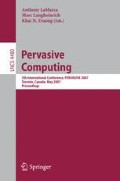Abstract
Radio frequency identification (RFID) may be used to automatically detect, locate and/or identify objects, making it an ideal candidate for many pervasive computing applications. As RFID technology improves in terms of cost and performance, it is increasingly being explored in a variety of applications, ranging from eldercare through to the smart supply chain. However, while passive UHF RFID has many benefits over other RFID variants, reliable operation as the tag moves in the environment is inherently difficult to predict and can represent a significant challenge. In this paper, we present a novel and practical experimental method called attenuation-thresholding which may be used to characterize the operating range of such RFID systems. The results presented demonstrate the advantages of our method over the conventional read-rate approach. We also demonstrate a novel approach to collecting the measurements in range characterization experiments using robotic automation. Finally, we show how the application of attenuation-thresholding in combination with robotic automation can be used to optimize tag placement on an object. In addition to the clear relevance of this work to the many RFID-based pervasive computing applications reported in the literature and currently under development, it also has broad applicability in other RFID application domains. We conclude with a number of ideas for future extensions to this work.
Access this chapter
Tax calculation will be finalised at checkout
Purchases are for personal use only
Preview
Unable to display preview. Download preview PDF.
References
Alien Technology: RFID training course materials (2003)
Auto-ID Center: 860MHz-930MHz Class 1 Radio Frequency (RF) Identification tag radio frequency & logical communication interface specification. EPCGlobal Inc. (2002), http://www.epcglobalinc.com/standards_technology/Secure/v1.0/UHF-class1.pdf
Balch, T., Feldman, A., Wilson, W.P.: Assessment of an RFID system for animal tracking. Tech. Rep. GIT-CC-04-10, Georgia Institute of Technology (2004)
Borriello, G., et al.: Reminding About Tagged Objects Using Passive RFIDs. In: Davies, N., Mynatt, E.D., Siio, I. (eds.) UbiComp 2004. LNCS, vol. 3205, pp. 36–53. Springer, Heidelberg (2004)
Blake, L.V.: Radar Range-Performance Analysis. Lexington Books, Lanham (1980)
Chappell, G., et al.: Auto-ID on Delivery: The Value of Auto-ID Technology in the Retail Supply Chain. Auto-ID Center whitepaper, ACN-AUTOID-BC-004 (2002)
Cushcraft: S9028PC12NF product datasheet. Cushcraft, Inc., http://www.cushcraft.com/comm/support/pdf/S9028PC12NF.pdf
Decker, C., Kubach, U., Beigl, M.: Revealing the Retail Black Box by Interaction Sensing. In: Proceedings of the ICDCS 2003, Providence, Rhode Island (2003)
Dobkin, D.M., Weigand, S.W.: Environmental Effects on RFID Tag Antennas. In: Microwave Symposium Digest, 2005 IEEE MTT-S International Microwave Symposium (2005)
The Economist: The best thing since the barcode (February 2003)
Fanuc Robotics: Fanuc M6 and M16 series product overview, http://www.fanuc.co.jp/ja/product/catalog/pdf/m6ib-je03.pdf
Finkenzeller, K.: RFID Handbook: Fundamentals and Applications in Contactless Smart Cards and Identification. John Wiley & Sons, Chichester (May 2003)
Griffin, J.D., et al.: RF Tag Antenna Performance on Various Materials Using Radio Link Budgets. IEEE Antennas and Wireless Propagation Letters 5 (2006)
Hightower, J., Borriello, G.: Location systems for ubiquitous computing. IEEE Computer 34 (2001)
Hodges, S., McFarlane, D.: RFID: The concept and the impact. In: The Security Economy, pp. 55–75. Organisation for Economic Cooperation and Development (2004), Available at http://www1.oecd.org/publications/e-book/0304031E.PDF
Jiang, B., et al.: Unobtrusive Long-Range Detection of Passive RFID Tag Motion. IEEE Transactions on Instrumentation and Measurement 55(1) (2006)
Kraus, J.D.: Antennas, 2nd edn. McGraw-Hill Education, New York (1988)
Kwon, H., Lee, B.: Evaluation of RFID Tag Antenna Performance Using Radar Cross Sections. In: The European Conference on Wireless Technology, pp. 491-493 (2005)
Lee, H., et al.: Assessing the Value of RFID Technology and the EPC Standard for Manufacturers. EPCGlobal Whitepaper (2005)
Shenoy, P.D., Liu, X., Corner, M.D.: Ferret: RFID Localization for Pervasive Multimedia. In: Dourish, P., Friday, A. (eds.) UbiComp 2006. LNCS, vol. 4206, pp. 422–440. Springer, Heidelberg (2006)
Mallinson, H., Hodges, S., Thorne, A.: Determining a Better Metric for RFID Performance in Environments with Varying Noise Levels. In: 12th IEEE International Conference on Methods and Models in Automation and Robotics (2006)
Mitsugi, J., Hada, H.: Experimental Study on UHF passive RFID Readability Degradation. In: Proceedings of the International Symposium on Applicatoins and the Internet Workshops (2005)
P7011-6A programmable attenuator DC to 1,000MHz datasheet. Pasternack Enterprises LLC, http://www.pasternack.com/Pdf/PE7011-6A.pdf
Penttilä, K., et al.: Radar cross-section analysis for passive RFID systems. IEE Proceedings of Microwave Antenna and Propagation 153(1) (2006)
Philipose, M., et al.: Inferring activities from interactions with objects. IEEE Pervasive Computing 3(4), 50–57 (2004)
Ramakrishnan, K.M., Deavours, D.D.: Performance Benchmarks for Passive UHF RFID Tags. In: Proceedings of the 13th GI/ITG Conference on Measurement, Modeling, and Evaluation of Computer and Communication Systems, pp. 137–154 (2006)
Rappaport, T.S.: Wireless communications, 2nd edn. Prentice-Hall, Englewood Cliffs (2002)
Redemske, R., Fletcher, R.: Design of UHF RFID Emulators with Applications to RFID Testing and Data Transport. In: Proceedings of 4th IEEE Conference on Automatic Identification Technologies (October 2005)
Roy, S., et al.: A Wirelessly-Powered Platform for Sensing and Computation. In: Dourish, P., Friday, A. (eds.) UbiComp 2006. LNCS, vol. 4206, pp. 495–506. Springer, Heidelberg (2006)
Staake, T., Thiesse, F., Fleisch, E.: Extending the EPC network: the potential of RFID in anti-counterfeiting. In: SAC ’05: Proceedings of the 2005 ACM Symposium on Applied Computing, pp. 1607–1612 (2005)
Wan, D.: Magic Medicine Cabinet: A Situated Portal for Consumer Healthcare. In: Gellersen, H.-W. (ed.) HUC 1999. LNCS, vol. 1707, Springer, Heidelberg (1999)
Want, R., et al.: Bridging Physical and Virtual Worlds with Electronic Tags. In: Proc. of ACM SIGCHI, pp. 370–377 (1999)
Author information
Authors and Affiliations
Editor information
Rights and permissions
Copyright information
© 2007 Springer Berlin Heidelberg
About this paper
Cite this paper
Hodges, S., Thorne, A., Mallinson, H., Floerkemeier, C. (2007). Assessing and Optimizing the Range of UHF RFID to Enable Real-World Pervasive Computing Applications. In: LaMarca, A., Langheinrich, M., Truong, K.N. (eds) Pervasive Computing. Pervasive 2007. Lecture Notes in Computer Science, vol 4480. Springer, Berlin, Heidelberg. https://doi.org/10.1007/978-3-540-72037-9_17
Download citation
DOI: https://doi.org/10.1007/978-3-540-72037-9_17
Publisher Name: Springer, Berlin, Heidelberg
Print ISBN: 978-3-540-72036-2
Online ISBN: 978-3-540-72037-9
eBook Packages: Computer ScienceComputer Science (R0)

